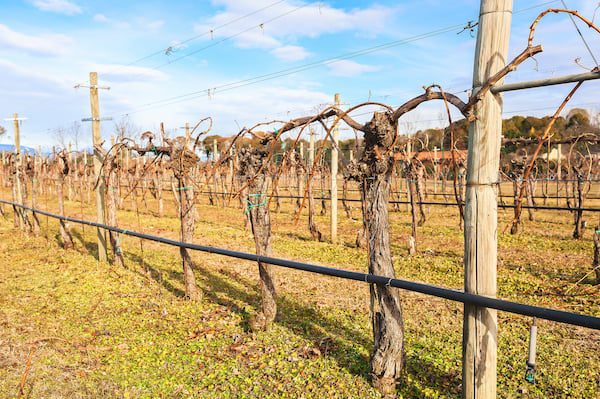Across the nearly 1 million acres of grapes in California, early-season irrigation strategies vary by necessity. The right strategy for each individual operation depends on a variety of factors, such as the grower’s goals—for example, a high- or low-tonnage crop—the water already available in the soil, and the maturity of the plant.
But in 2021, early-season irrigation has become a must for vineyards all across California in the wake of another disappointingly dry winter. Growers who might otherwise wait until later to begin irrigating should be mindful that early-season irrigation in particular must consider and compensate for the previous lack of rainfall.
That's because a successful season depends on healthy growth of the plant in the spring. At recent Lodi Wine Growers event, Mark Battany, water management and biometeorology advisor with University of California Cooperative Extension, suggested that growers orient their irrigation strategy for the year around three key phases in development: budbreak through fruit set, post- fruit set through veraison, and veraison through harvest.
“The concepts can be applied anywhere,” said Battany. “This is pretty much global in nature. So it doesn’t matter where in the world you are at, we’re really trying to achieve, often, similar things.”
Bud break through fruit set
The early part of the grape-growing season is all about developing maximum vegetative growth to promote a strong, healthy canopy as quickly as possible—which means when it comes to the early-season irrigation season, it's full steam ahead. Applying water during this period of low water stress helps promote rapid growth: successful flowering and fruit set, as well as good bud development for the following season.
Post- fruit set through verasion
After the canopy has reached the desired size and the vines begin to flower and set fruit, scale back irrigation to prevent excessive vegetative growth and create a balance between fruit and canopy. This should be a period of higher water stress. “There is this relationship between water and sugar and acidity,” said Mallika Nocco, University of California Cooperative Extension specialist and director of the Conservation Irrigation Lab in Davis. "It’s done to control the quality of the grape.”
Verasion through harvest
When fruit reaches veraison, the purpose of irrigation shifts to simply maintaining the canopy’s functional foliage to support fruit ripening—with the goal of limiting or preventing any new vegetative growth. This final stage is one of moderate water stress that helps plants reach a grower’s desired sugar level in the fruit.

“All three of these periods have very different vine water stress situations in order to achieve these outcomes,” said Battany.
In addition to water, nitrogen inputs early in the season are also an important part of achieving rapid canopy growth.
Insufficient water or nutrients, and the canopy will not fully develop—stunting the plant's growth and creating a deficit from which it will be difficult or even impossible to recover. Too much, and the canopy will become too full, blocking out light, limiting air circulation, and potentially creating conditions that foster disease. An overgrown canopy early in the season creates risk of defoliation when growers do finally cut the water, which in turn leaves fruit exposed to the elements.
How to strike the right balance? Early in the season, growers should learn what they can about their vineyard's starting point for soil moisture content—as it can vary significantly even within a given region. Vines reach deep into the soil to pull water, so soil moisture variation can be present at surprising depths—especially when one drought year follows one another.
Aerial data offers a cost-effective and precise route to assessing water stress across the entirety of the vineyard—as well as timely insights to guide canopy management. Contact us to learn more.
